ÌÀÒÅÌÀÒÈÊÀ/1.Äèôôåðåíöèàëüíûå è èíòåãðàëüíûå óðàâíåíèÿ
Dokukova N.A., Kaftaikina E.N., Zenkovich V.V.
Belarusian state university,
Belarus
General
patterns of improper vibrations of
dynamical systems with an arbitrary number of degrees of freedom
This article presents a calculation method
of improper vibrations dynamic
systems with an arbitrary number of degrees of freedom
by reducing the system of linear ![]() -bonded non-homogeneous second order differential equations to
-bonded non-homogeneous second order differential equations to ![]() -independent from each other differential
equations of 2
-independent from each other differential
equations of 2![]() -order. Obtained
general results allow to determine the
criteria for the selection of
rational physical and geometrical parameters of the original mechanical system based on sustainability and quality of the dynamic model [1-5].
-order. Obtained
general results allow to determine the
criteria for the selection of
rational physical and geometrical parameters of the original mechanical system based on sustainability and quality of the dynamic model [1-5].
Vibrations of mechanical systems with ![]() degrees
of freedom equal to the system represented in the form of
degrees
of freedom equal to the system represented in the form of ![]() -linear second
order differential equations:
-linear second
order differential equations:
 (1)
(1)
Introduce the notations similar
to those shown in [1, 2]
 (2)
(2)
Then (1) in
the new notation, (2) can be
rewritten as follows:
 (3)
(3)
It can be represented in matrix
form:
 (4)
(4)
Matrix elements are linear differential
operators (2).
System (1) can be reduced to a system of
independent linear ordinary differential equations of 2N-order disconnected to each other using certain non-singular linear transformations:
![]() . (5)
. (5)
The right side consists
of a combination of functions ![]() and their derivatives.
and their derivatives.
Linear differential operator of the following form is on the
left side of each new differential equation:
![]() , (6)
, (6)
![]() is the
determinant of the system (1)
is the
determinant of the system (1)
 . (7)
. (7)
The right side of
the equations system (5) are functions ![]() , determined
by the determinants of matrices.
, determined
by the determinants of matrices.
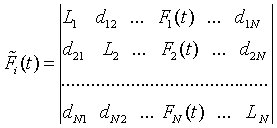 , (8)
, (8)
The i-th column
consists of functions ![]() , taken from (1),
at the other places are the elements of the system (4).
, taken from (1),
at the other places are the elements of the system (4).
Inhomogeneous linear differential equation of 2N-order is obtained for each unknown variable ![]() , independent of other unknown variables
, independent of other unknown variables![]() , found from the system of equations (3)
using form (4), which can be rewritten
as follows:
, found from the system of equations (3)
using form (4), which can be rewritten
as follows:
 . (9)
. (9)
The differential operators ![]() can be considered as elements
belonging to a commutative ring
can be considered as elements
belonging to a commutative ring ![]() . Such ring would
be the space of differential operators
of the form
. Such ring would
be the space of differential operators
of the form ![]() , where
, where ![]() - real numbers,
and
- real numbers,
and ![]() - differential
operator. Elements of the determinant (9) are linear differential operators,
which have algebraic properties due to
their linearity and
differentiability. Adoption (9)
follows directly from Cramer's rule for
linear systems of algebraic equations. Prove this assumption.
- differential
operator. Elements of the determinant (9) are linear differential operators,
which have algebraic properties due to
their linearity and
differentiability. Adoption (9)
follows directly from Cramer's rule for
linear systems of algebraic equations. Prove this assumption.
Put ![]() - twice continuously differentiable function defined on an interval
- twice continuously differentiable function defined on an interval ![]() , such that,
when substituted into equations (1), it becomes
an identity:
, such that,
when substituted into equations (1), it becomes
an identity:
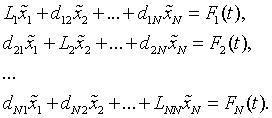 (10)
(10)
Multiplying the first
equation of (10) by the cofactor ![]() of the element
of the element ![]() in the main
matrix of the system, then multiply the
second equation by
in the main
matrix of the system, then multiply the
second equation by ![]() , the third by
, the third by![]() and so on. Sum up
all these equalities. The result is the following relationship:
and so on. Sum up
all these equalities. The result is the following relationship:
 . (11)
. (11)
Then the operator at
![]() is equal to the
determinant
is equal to the
determinant![]() of the main system matrix, operators at the other
of the main system matrix, operators at the other ![]() is equal to the zero
operator on the basis of the known algebraic equation
is equal to the zero
operator on the basis of the known algebraic equation
![]() .
.
A solution of equation
(11) is the equation, which determines the desired unknown function ![]()
![]() . (12)
. (12)
Using the same
method differential equations are obtained for the other functions ![]() ,
, ![]() from
equations (9).
from
equations (9).
Linear transformation of differential equations allows us to pass from a
connected system of linear equations
(1) to an equivalent system of
disconnected linear equations,
but higher order
 (13)
(13)
Having at the left side of the
equation a polynomial with coefficients ![]() that are some
combination coefficients of the original system (1).
that are some
combination coefficients of the original system (1).
As an example, consider a model with
six degrees of freedom and the following initial conditions:
x1(t) = 0.5, x2(t) = 0.5, x3(t) = 0.8, x4(t) = 0.3, x5(t) = 0.04, x6(t) = 0.2,
x1¢(t) = 1.04, x2¢(t) = 2.3, x3¢(t) = 3.07, x4¢(t) = 1.6, x5¢(t) = 1.002, x6¢(t) = 2.5.
Introduce
additional notation:
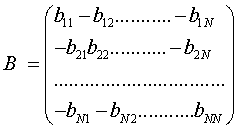 ,
,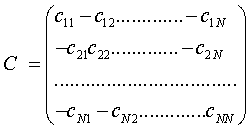 (14)
(14)
Then the system (1) in matrix
form becomes:
![]() , (15)
, (15)
Matrix elastic
and damping coefficients of
the canonical representation (14) is the
following
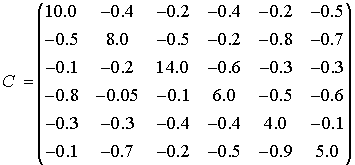 ,
,
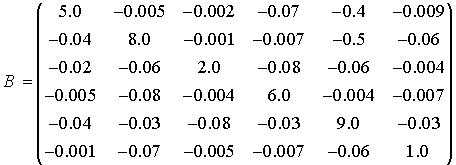 ,
,
 .
.
Find the solution of six non-connected
with each other differential equations
- improper
vibrations of a dynamical system with six degrees of freedom (15) in the
general form using obtained the general system of ![]() - independent differential equations of
- independent differential equations of ![]() order represented
by (5):
order represented
by (5):










![]()



![]()






Charts of analytic solutions of inhomogeneous
differential equations (15), describing the oscillations of a system with six degrees of freedom are shown in Figure
1 and Figure 2 for the time interval from 0 seconds to 15 seconds.
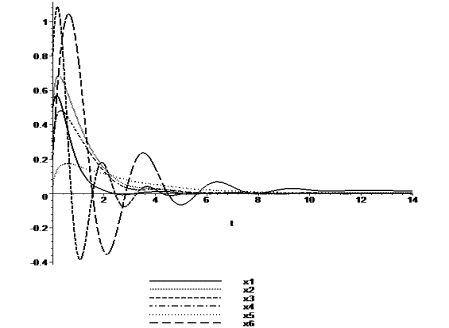
Figure 1 - Accurate analytical solutions ![]() of inhomogeneous
differential equations corresponding to the time of acceleration of
the mechanical system
of inhomogeneous
differential equations corresponding to the time of acceleration of
the mechanical system
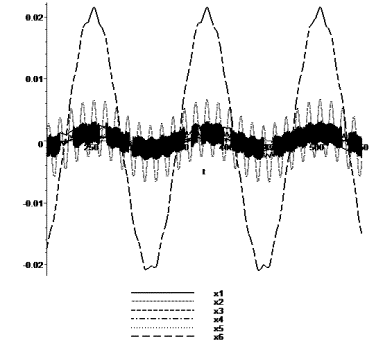
Figure 2 - Accurate analytical solutions ![]() of inhomogeneous differential equations in the interval
of inhomogeneous differential equations in the interval ![]() seconds, corresponding
to the steady state of a mechanical system
seconds, corresponding
to the steady state of a mechanical system
The system of six related non-homogeneous
differential equations with separable
variables is integrated analytically. Accurate theoretical results of its own and forced vibrations
are obtained using the known initial velocity and
displacement data provided
by the method.
References:
1.
N. A.
Dokukova and P. N. Konon Generalities of passive vibration dampers isolating
vibrations// Journal of Engineering Physics and Thermophysics, 2006, Volume 79,
Number 2, Pages 412-417, Publisher Springer New York, ISSN: 1062-0125.
2.
N. A.
Dokukova and P. N. Konon General laws governing in mechanical vibratory
systems// Journal of Engineering Physics and Thermophysics, 2006, Volume 79,
Number 4, Pages 824-831, Publisher Springer New York, ISSN: 1062-0125.
3.
N. A.
Dokukova, M. D. Martynenko and E. N. Kaftaikina Nonlinear vibrations of
hydraulic shock absorbers// Journal of Engineering Physics and Thermophysics,
2008, Volume 81, Number 6, Pages 1197-1200, Publisher Springer New York, ISSN:
1062-0125.
4. N. A. Dokukova, P. N. Konon
and E. N. Kaftaikina Nonnatural vibrations of hydraulic shock-absorbers//
Journal of Engineering Physics and Thermophysics, 2008, Volume 81, Number 6,
Pages 1191-1196, Publisher Springer New York, ISSN: 1062-0125.
5. N. A. Dokukova, P. N.
Konon On the equivalence of the
methods of impedance and
amplitude-frequency characteristics for the study of oscillations in
a gyro dampers // Journal of Engineering Physics and
Thermophysics, 2003. Volume 76, Number 6. Pages 115-118.